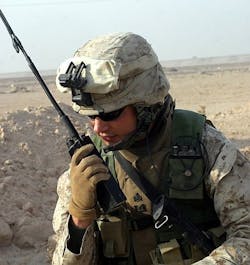Air Force asks industry for hand-held Link-16 special operations networking radios
WRIGHT-PATTERSON AFB, Ohio, 14 May 2013. U.S. Air Force special operations experts are surveying industry to find companies able to design and build a small hand-held Link-16 secure, jam-resistant, high-speed digital data radio that is no larger than today's fielded AN/PRC-148 multiband inter/intra team radio (MBITR).
The Air Force Life Cycle Management Center (AFLCMC) Battlefield Airmen Branch (WISN) at Wright-Patterson Air Force Base, Ohio, has issued a request for information (Form-Factor_Link-16_radio) for a very small form-factor Link-16 radio.
Link-16 Link-16 is a NATO military tactical data exchange network that enables fighting forces to exchange their tactical pictures in near-real time, as well as send and receive text messages, imagery data, and two channels of digital voice.
Link-16 radios typically are aboard aircraft, ships, and combat vehicles, but the Air Force wants to develop hand-held Link-16 radios that are small enough for battlefield airmen to use while on foot. Battlefield Airmen are the special operations force of the Air Force, and include combat controllers, para-rescumen, tactical air control party members, and special operations weather technicians.
Battlefield Airmen are extensively trained and often operate far into hostile territory, and provide a key link between the air and ground. They perform surveillance, weather forecasting, airfield surveying, air traffic control, air strike direction, airdrop marking, trauma care, and personnel recovery.
These special operations forces need a way to communicate with other Link-16 aircraft, ships, and combat vehicles without the need to carry excess bulk into the field.
Link-16 is a TDMA-based secure, jam-resistant high-speed digital data link which operates in frequencies from 960 to 1,215 MHz, which limits its use to line of sight, by tactical Internet, or by satellite communications (SATCOM) links.
The Air Force wants a Link-16 radio no larger than the MBITR, the 152/152A; it even could be as small as the RT-1922 microlight SADL radio.
This requirement calls for a small, lightweight, ruggedized tactical data link terminal to be worn by a battlefield airman for sending and receiving Link-16 messages and J voice communications while on foot or in a vehicle.
The radio should provide reliable, secure, Link-16 network connectivity and J-voice, as well as be NSA certified. The terminal should be ergonomically and functionally similar to the MBITR or AN/PRC-152 hand-held radios, and use a 5.8-hour lithium ion battery and single bay or six bay charger.
The transceiver must connect to a computer or similar hand-held device through an Ethernet and/or USB 2.0 connectors. The radio also should have a 6 pin multifunction connector, and be able to survive immersion in water as deep as six feet.
Companies interested should respond no later than 30 May 2013 by email to the Air Force's Jarrett Stamper at [email protected], or Michael Longstreath at [email protected].
For questions or concerns, contact Jarrett Stamper by email at [email protected], or by phone at 937-255-9903.
More information is online at https://www.fbo.gov/spg/USAF/AFMC/ASC/Form-Factor_Link-16_radio/listing.html.
